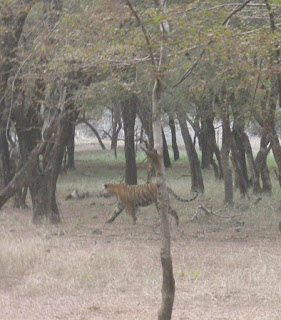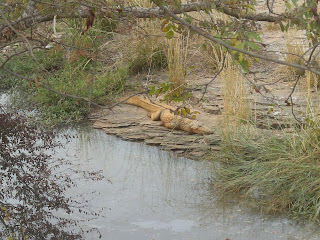On Day eight of the trip we left Jaipur and began the bumpy ride to Ranthambore National Park. When we moved further from Delhi, the roads became very narrow and very bumpy. As we drove through many of the villages, cows roamed the streets freely because they are sacred to the Hindu religion. The primary method of transportation still was the motorcycle with some automobiles. We saw no chain or big box stores in any of the villages. The countryside economy is made up of small individual shops. There were vegetable and meat shops everywhere. Just for your information, importation of autos carries a very large tarrif so all automobiles are manufactured in India.
Ranthambore borders the outer fringes of the Thar Desert and the former hunting grounds of the Maharjah of Jaipur. The park is now a 512 square mile natural preserve and one of India's largest. It is home to a diverse plant life, historic ruins, and hundreds of species of bird, reptiles, mammals and of course, Bengal tigers.
Ranthambore belongs to India's groundbreaking Project Tiger. This program is dedicated to preserving and protecting the once plentiful Royal Bengal tigers that roamed the land. Now threatened by poachers, illegal logging, and encroaching civilization, India's tiger population has decreased precipitously. It is believed that just 34 tigers currently live in Ranthambore. National Project Tiger has seen the Bengal population rise to about 4,000 from the 2,000, counted when the project launched in 1973. The park's varied landscape of beautiful lakes, lush grasslands, deep ravines, wooded valleys and open scrub also features picturesque ruins of old fortifications and the thousand-year old Ranthambore Palace.
The park is closed from July through August due to the monsoons. Our group was very fortunate with the time of the year being the end of November and the dry season. Viewing and touring of the park takes place in a jeep type of vehicle, although much larger and very elevated. Each vehicle would hold about 10 to 12 people depending on the seating arrangement. We were extremely lucky in that our vehicle only had 5 people in it from the tour.
In addition to a driver and an assistant driver, the government of India supplies a naturalist. This person spoke perfect english and had a biology background. Each of these people had extensive knowledge of the park and plant and animal life. This made touring in the park much more interesting as trees, plants, birds, and other animals were readily identified. They also gave background information as to the type of habitat each species would search out.
The park is divided into 4 zones for viewing. Excursions only take place in the early morning and late afternoon to almost evening. The tour groups' vehicles picked everyone up at the hotel. We were introduced at that time to the park personnel and the naturalist that would be accompaning each vehicle. We were informed at that time about the slim possibility of seeing a tiger and how rare an event it would be.
In our vehicle everyone was surprised. We got to see one of the rare tigers up close and in hunting mode. This was a rare viewing. As we were touring the park near a lake with tall grass surrounding it, we were watching a deer. The park was full of peacocks and they began to make a screeching noise. In addition the monkeys that were everywhere near the lake, joined in. The naturalist informed us that the peacocks and monkeys had seen a tiger. The next series of pictures is of the tiger emerging from the tall grass and stalking a deer. What was really interesting was the deer took a couple of steps and the tiger just laid down in the grass and rolled over. He watched the deer for about 30 minutes, then just got up and walked away. The naturalist informed the group that he was probably not hungry.
Next morning, a dead deer was found near where we had seen the tiger, and it was assumed that during the night he had some dinner.
The following series of pictures are from the three excursions we made into the park.
 |
| Banyan Tree. This is actually one tree. Its branches shoot out which grow down to the soil and form secondary trunks. |
 |
| This is the Sambar deer the tiger began to stalk. The Naturalist said we might witness the tiger make a kill. It didn't happen. |
 |
| After the deer took just a couple of steps away, the tiger laid down, rolled over a couple of times, licked his paws, and watched the deer. Then he got up and left. Here he is leaving. |
Good hunting, good fishing, and good luck. Hank
After Christmas is a great time to stock up on gear. The big stores want to get rid of all their hunting inventory and ammunition and now is the time to stock up. I buy all my ammo after Christmas when the discounts go deep.
http://www.outdoorswithhank.com/
Text





































.jpg)